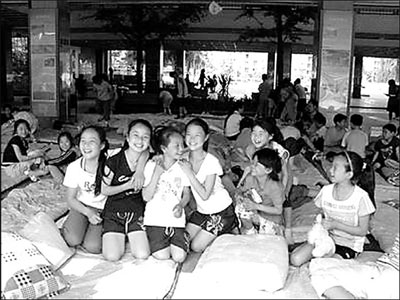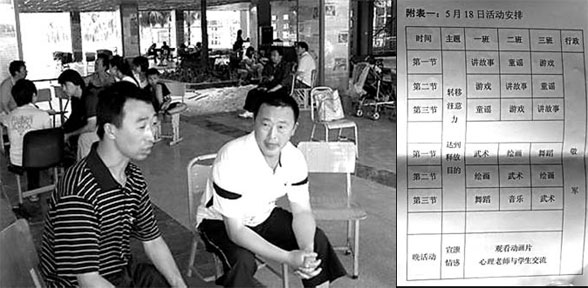One school's miracle escape
About 2:20 pm on May 12, young Deng Lijun - with the same name as the late singing legend Teresa Teng from the 1980s - made her way down three flights of stairs to the restroom, 10 minutes before joining her classmates in their exercises. She was allowed to leave early because her left leg, hindered by polio, made walking difficult.
As she reached the open area on the first floor, the ground began to quiver and rumble. She ran with all her might, crawling if she fell, until she reached a bamboo grove on the school grounds. A teacher had called for everyone to gather, so Deng and several female classmates joined the group in the open space.
All 483 students from her elementary school were led away from the shaking building.
|
Students of Dengjia Liuhan Primary School in Beichuan share a happy moment in Mianyang.Photos by Li Chengpeng |
It was a miracle. Elsewhere in Beichuan, the 8.0-magnitude earthquake buried more than 2,000 students. What is more, nine teachers had led 71 students who lost contact with their families on a harrowing journey to reach the city of Mianyang. The youngest one among the students is 4 years old.
Teacher Xiao Xiaochuan later "tricked" students into descending the mountain.
If asked to explain what he did on May 12, Xiao Xiao probably would not be able to answer. No one taught the teacher how to evacuate a building in a disaster.
Yet he managed to do it with near scientific precision and amazing efficiency.
Last Monday morning, the teacher was reading in his office when he noticed his book shaking on the table. Frightened, he and a school patrol officer shouted for the students to run to the drill area outside.
An evacuation expert said that Xiao and the students carried every step of what could be found in a standard survival handbook. They squatted low to the ground. They ran to a lower level and then out into the open. They constructed simple tents.
The group could not stay on the grounds for long, however. Mud and rocks flowed down the mountain, and the quake had already demolished a town below. Xiao helped the children to higher ground.
He chopped down bamboo and scavenged scraps of cloth to construct a rudimentary tent. It was so crowded in the makeshift shelter that the 483 students huddled together back-to-back the whole night, with no room to move. Like a shepherd guarding his sheep, the teacher watched over his students.
Outside, rain fell in wild torrents. Loose boulders thundered down the slopes, and tremors continued to jostle the dark mountain.
Later, little Deng smiled as she recounted their escape; she remembered who stumbled and who cried for their mothers.
Still, one may wonder why nine teachers and 71 students attempted to reach Mianyang. Why did they not wait for rescuers to arrive?
The survivors said they knew the county officials were likely to have been busy helping those who were buried by the quake. They had to save themselves.
Their daunting escape route included three mountains, each 2,000 m above sea level: Shuidongzi, Jingjiashan, and Yangliuping. They faced a long list of dangers: Aftershocks, mud flow, falling rocks, heavy rain, altitude sickness, and a thick, ancient forest.
One teacher, Wu Mingse, had turned a worrisome shade of blue because of her severe asthma. Many asked if she was well enough to make the journey.
"I have to, no matter what. I refuse to die here," she told them.
On the second day, the sky suddenly darkened. A thick, freezing fog plunged the forest into deep, impenetrable gloom. The children could not see their classmates just 2 m away. It seemed as if an evil spirit had enveloped them, they later recalled. Village superstition told them that the ghoul could kill its victims by stealing their souls.
The group plowed on, shouting each other's names at the top of their voices across the lonely forest to frighten away the spirit.
Jingjiashan Mountain was notoriously hard to navigate. The locals have a saying: "Don't let your daughter marry into Jingjiashan Mountain", meaning the roads were treacherous for a wedding procession. Likewise, men who rode through the mountain anchored themselves with strips of woven bamboo to avoid plunging over the cliffs.
The earthquake created a fissure in the mountain massif. Mud and rock oozed down. Even more worrisome for the escapees were the paths, which had become wildly distorted. When they expected to walk uphill, the path turned downhill. A familiar left turn suddenly dropped into sheer cliffs.
It was a ragtag group that scurried along the twisted paths. The older children helped the younger ones, pulling them along as they ran. Every few minutes someone lost a shoe, which the teachers either picked up or replaced with another swiped from villages they passed.
Two packs of cookies and a few bottles of water was all the food available for 71 children and eight adults. The children lined up for their sliver of cookie and one gulp of water. One could practically hear those at the back of the line salivating. The teachers were heartbroken, and some wept openly.
Even more disappointingly, the group had passed two families on the road with enough resources to temporarily take care of the children, but for various reasons, they refused.
Yet the children did not give up. Later, the teachers said they encouraged them with promises of sweets, bread, ice cream, and Coca-Cola when they reach Mianyang. They would get to meet the policemen, whose job was to save people, and whom the little ones frequently saw on television.
They finally arrived at a toll station. The county magistrate asked how many were still alive.
"We didn't lose a single one," Xiao said.
But there was no candy or ice cream yet; everyone was too busy getting ready for the drive to Mianyang. That night, the children slept soundly on the bus.
Though they were still at the point of exhaustion the next day, the youngsters were exhilarated to see the sprawling metropolis. It was badly damaged by the quake, but for some, it was the first glance at a big city. For the group that had traveled several hellish days, Mianyang seemed like heaven itself.
The story first appeared on Tuesday in the Beijing Youth Daily
|
(Left): Xiao Xiaochuan (right) stays with his students in Yingcai School in Mianyang. (Right): A class schedule with games and story-telling classes arranged by Yingcai School to switch the children's attention from the earthquake. |
(China Daily 05/22/2008 page20)
















